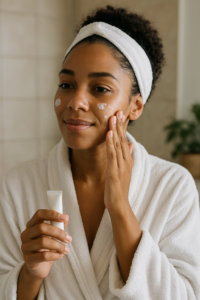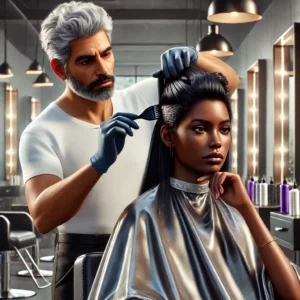Consumer Reports Investigation Reveals Dangerous Chemicals in All Tested Braiding Hair Brands
A recent Consumer Reports investigation has discovered cancer-causing chemicals in all 10 synthetic hair products tested for braids, extensions, and other protective hairstyles popular among Black women. The groundbreaking study, published February 27, 2025, found that popular brands, including Magic Fingers, Sensationnel, and Shake-N-Go, contained various carcinogens, while nine of the ten products also tested positive for lead. One product exceeded California’s maximum allowable lead dose by more than 600%, a particularly alarming finding given that these synthetic hair products are typically worn for four to six weeks at a time, creating extended exposure to potentially harmful substances that could pose significant health risks to millions of consumers.
5 Key Points
- All 10 synthetic hair brands tested by Consumer Reports contained carcinogenic chemicals, including benzene, which is known to cause acute myeloid leukemia.
- Lead was detected in 9 out of 10 products tested, with one brand exceeding California’s safety threshold by more than 600%.
- The products are commonly used in protective hairstyles worn for 4-6 weeks, creating prolonged chemical exposure.
- Major manufacturers, including Sensationnel and Magic Fingers, disputed the testing methodology but did not provide evidence of their safety testing.
- Black consumers represent over 70% of the hair extension market, with 5.5 million Black women potentially exposed to these chemicals.
What Harmful Chemicals Were Found in the Synthetic Hair?
Consumer Reports investigators discovered a disturbing array of toxic substances in the synthetic hair products they tested. They detected benzene, a known carcinogen linked to acute myeloid leukemia, in three of the products, including those from Sensationnel and Magic Fingers. All samples contained methylene chloride, which regulatory agencies classify as a probable carcinogen linked to liver and lung cancer after long-term exposure. The Food and Drug Administration permits no level of methylene chloride in cosmetics, raising serious questions about regulatory oversight of these widely used products. Testers also found volatile organic compounds (VOCs) in every product examined, with Magic Fingers products containing more than five million VOCs, including acetone, toluene, and 1,2-dichloroethane. These chemicals are released when the hair is heated, such as when stylists dip ends in boiling water during installation, creating additional exposure risks.
Lead contamination emerged as another serious health threat, with researchers finding this neurotoxin in nine of the ten products. Lead causes developmental issues in children and reproductive problems in adults. The Sassy Collection’s Jumbo Braid product showed particularly alarming lead levels, exceeding California’s maximum allowable dosage level by 610%. Consumer Reports researchers used California’s standards because federal regulators have established no specific limits for lead in synthetic braiding hair, highlighting a significant regulatory gap. Only one product, Sensationnel X-Pression, tested negative for lead. James Rogers, Director and Head of Product Safety Testing at Consumer Reports, emphasized the extended exposure concern, noting that “braids are often worn for many weeks, and prolonged, repeated exposure increases your risk.” The cumulative exposure over time may pose greater risks to frequent users, especially considering many consumers, including children, wear these styles repeatedly throughout the year.
Why Are Black Women Particularly Vulnerable to These Exposures?
Synthetic hair has become a cornerstone of Black hair care culture, with braids, locs, and twists serving as both protective styles and important cultural expressions. Market researchers have found that Black consumers represent over 70% of the hair extension market, spending approximately six times more on hair care than other ethnic groups. Hair companies specifically target these consumers, with 34% of adult American Black female internet users reporting wearing braids with synthetic extensions within the last three years. For many users, these styles represent more than fashion—they provide time-saving alternatives to daily hair maintenance while protecting natural hair from breakage and damage. This creates a situation where a specific demographic bear’s disproportionate exposure to potentially harmful chemicals through products marketed directly to them.
The extended wearing time compounds potential health risks. Unlike products that users apply briefly and wash away, synthetic braids typically remain in place for 4-6 weeks, creating continuous contact with these chemicals. Medical researcher Chrystal Thomas from the Albert Einstein College of Medicine pointed out this unique risk factor: “What is unique about braid extensions is the length of exposure users have to them. Black women and other individuals who use synthetic hair are, therefore, exposed to those ingredients consistently during that time.” This extended exposure may increase absorption through the scalp and inhalation of volatile compounds. The health implications concern experts, particularly given that Black women already face higher rates of certain endocrine disorders, breast cancer mortality, and uterine disease compared to other demographics. The 2022 class-action lawsuit against chemical hair relaxer companies, where hundreds of Black consumers alleged products led to uterine cancer, further highlights this pattern of toxic exposure through hair products marketed to Black women.
How Have Manufacturers Responded to the Findings?
The companies implicated in the Consumer Reports investigation have largely defended their products while questioning the testing methodology. Sensationnel released a statement claiming they were “extremely surprised” by the information and “unequivocally stand by the safety of Sensationnel products.” The company urged consumers to “continue to confidently use Sensationnel products” while emphasizing its 35-year history as a family-run business that takes product safety seriously. Similarly, Magic Fingers challenged the test results and methodology, stating that their customers “can count on us for braids and extensions that meet their highest expectations for fashion and performance.” Both companies argued that Consumer Reports’ testing methods did not accurately represent real-world usage of their products, though neither provided evidence of their own safety testing protocols or results.
Kaneka, which manufactures the Kanekalon fibers used in many synthetic hair products, attempted to distance itself from the findings by clarifying its limited role in the supply chain. The company told Consumer Reports that it “only manufactures the Kanekalon fibers that are used in various hair products, such as synthetic hair braids and wigs, and does not produce any of the final products.” They noted that the braiding hair companies themselves handle the dyeing and styling of the Kanekalon fibers. Kaneka also requested more information to analyze the complaint properly, suggesting they had not previously conducted comprehensive safety testing for these applications. Shake-N-Go did not respond to requests for comment from either Consumer Reports or NBC News, leaving questions about their manufacturing practices and safety standards unanswered. Despite the concerning findings, the overall response pattern indicates a reluctance to acknowledge potential health risks or commit to reformulating products.
What Are the Regulatory Gaps and Potential Solutions?
The Consumer Reports investigation exposes significant regulatory gaps in the oversight of synthetic hair products. Federal regulators have established no limits specifically addressing lead or carcinogens in synthetic braiding hair, leaving consumers without basic safety protections. In response to these findings, Consumer Reports has launched a petition calling on the U.S. Food and Drug Administration to assert jurisdiction over synthetic braiding hair as a cosmetic product and establish strict standards limiting dangerous chemicals, particularly known carcinogens such as benzene and heavy metals like lead. This regulatory vacuum has allowed manufacturers to operate with minimal accountability for product safety, despite the widespread use of these products and their extended contact with consumers’ bodies.
The study’s findings also demonstrate that manufacturers can produce safer alternatives. Sensationnel X-Pression 3X Pre-Stretched Braid was the only synthetic hair sample that did not contain any detectable lead, proving that manufacturing processes can avoid at least some toxic contaminants. Several newer companies have also developed safer synthetic hair alternatives, including Rebundle, Nourie Hair, and Dosso Beauty, which claim to offer less toxic options. In the meantime, health experts recommend several precautions for consumers who continue using traditional synthetic hair products: washing the hair before installation, wearing gloves during installation, avoiding heating the hair with boiling water when possible, and taking breaks between installations to reduce cumulative exposure. For long-term solutions, increased regulatory oversight, comprehensive ingredient disclosure requirements, and investment in safer alternative materials would help protect the millions of consumers who regularly use these products.
FAQ
Q: What specific carcinogens did researchers find in the synthetic hair products?
A: Consumer Reports testing found multiple carcinogens across all products tested, including benzene (which causes acute myeloid leukemia) in three products, methylene chloride (a probable carcinogen linked to liver and lung cancer) in all samples, and various volatile organic compounds (VOCs). The synthetic fibers themselves are also typically made from vinyl chloride and acrylonitrile, both classified as carcinogens.
Q: How dangerous is the lead found in these products?
A: Lead is a neurotoxin that can cause serious health problems, particularly with long-term exposure. It has been linked to brain and nervous system damage, immune system suppression, reproductive issues, kidney damage, and hypertension. Lead especially endangers children, potentially causing developmental delays and impaired brain development. Nine of the ten products tested contained lead, with one exceeding California’s safety threshold by more than 600%.
Q: How do consumers get exposed to these chemicals when using synthetic hair?
A: Exposure occurs through multiple pathways: direct contact with the scalp during the 4-6 weeks the braids are typically worn, inhalation of volatile compounds released from the hair (especially when heated during installation), and hand-to-mouth transfer during handling. Professional braiders face additional exposure during the 5-8 hour installation process, particularly if they don’t wear protective gloves.
Q: How did the hair companies respond to these findings?
A: Two companies, Sensationnel and Magic Fingers, responded by challenging Consumer Reports’ testing methodology while asserting their products’ safety. Sensationnel stated: “We unequivocally stand by the safety of Sensationnel products.” Magic Fingers claimed their customers “can count on us for braids and extensions that meet their highest expectations.” Neither company provided evidence of their own safety testing. Shake-N-Go did not respond to requests for comment.
Q: Can I find safer alternatives to traditional synthetic braiding hair?
A: Yes, some newer companies have developed alternatives—brands like Rebundle, Nourie Hair, and Dosso Beauty claim to offer safer synthetic hair options. The Consumer Reports testing also showed that some products contained lower concentrations of toxic chemicals than others. Sensationnel X-Pression testing negative for lead demonstrated that safer manufacturing is possible even with traditional materials.
Q: How can I reduce my exposure risk while using synthetic hair?
A: Health experts recommend several precautions: wash synthetic hair before installation to remove surface chemicals, wear gloves during installation and handling, avoid heating the hair with boiling water when possible, ensure good ventilation during installation, take breaks between installations to reduce cumulative exposure, and report any adverse reactions to your doctor and the FDA.
Q: Do regulations exist governing the safety of synthetic braiding hair?
A: Federal regulators have established no limits specifically addressing lead or carcinogens in synthetic braiding hair, creating a significant regulatory gap. Consumer Reports is petitioning the FDA to assert jurisdiction over synthetic braiding hair as a cosmetic product and establish strict safety standards. Some state-level initiatives, like the New York Beauty Justice Act, aim to ban toxic substances in personal care products.
Citations
NBC News. (March 3, 2025). Synthetic hair marketed to Black women contains carcinogens and lead, report finds. https://www.nbcnews.com/news/nbcblk/synthetic-hair-carcinogens-lead-braids-extensions-black-women-rcna194213
Consumer Reports. (February 27, 2025). Synthetic Braiding Hair Test Results Detect Carcinogens and VOCs. https://www.consumerreports.org/health/wigs-hair-extensions/dangerous-chemicals-detected-in-braiding-hair-cr-tested-a4850978424/
U.S. News & World Report. (March 4, 2025). Lead, Toxic Chemicals Found in Synthetic Braiding Hair. https://www.usnews.com/news/health-news/articles/2025-03-04/lead-toxic-chemicals-found-in-synthetic-braiding-hair
AboutLawsuits.com. (March 4, 2025). Synthetic Braiding Hair Contains Cancer-Causing Chemicals: Consumer Reports. https://www.aboutlawsuits.com/synthetic-braiding-hair-cancer-causing-chemicals-consumer-reports
The Lancet Regional Health – Americas. (2023). Carcinogenic materials in synthetic braids: an unrecognized risk of hair products for Black women. https://www.thelancet.com/journals/lanam/article/PIIS2667-193X(23)00091-1/fulltext







